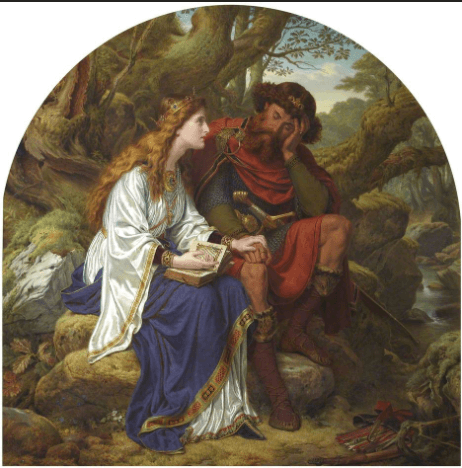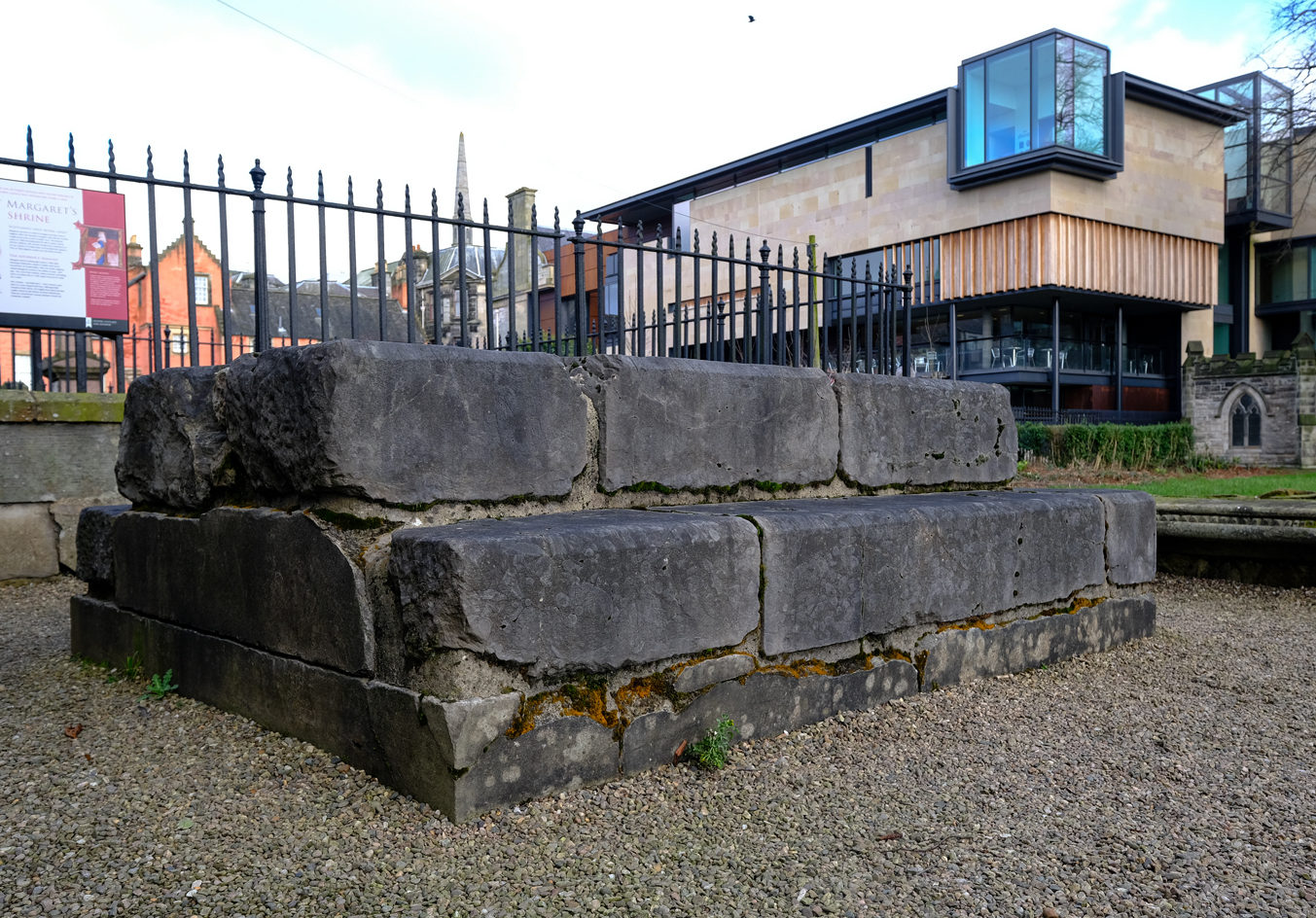In 1250 this shrine became the home of St Margaret’s relics, accompanied by King Malcolm Canmore’s remains. Among her relics was a chemise or sark that Margaret had worn. Margaret and Malcolm had eight children – six boys and two girls during their marriage 1070-1093. In a time of little medical knowledge or intervention, such a large family with no known infant deaths was rare indeed.
 Depiction of King Malcolm Canmore and Queen Margaret, Joseph Noel Paton, 1887. Photo credit: Fife Council, On loan from Carnegie Dunfermline Trust
Depiction of King Malcolm Canmore and Queen Margaret, Joseph Noel Paton, 1887. Photo credit: Fife Council, On loan from Carnegie Dunfermline TrustThis led to Margaret being viewed as positively charmed in relation to childbirth and her sark would be requested by other royal mothers who would pay to wear it during their own labour. It’s thought that Elizabeth de Burgh, queen consort to Robert the Bruce, wore the sark for the birth of their children.
Take our free audio tour to hear more about ‘St Margaret’s Journey’? To hear an extract, click the play button at the bottom left of the screen, or read the transcript below.
[Transcription of Audio]
Fiona: Hello, you made it! Welcome to Dunfermline, I’m excited to show you round my town.
Fiona: Did you know that Scotland has two patron saints? Everybody knows St Andrew, but not so much about St Margaret. We all learned a bit about her when we were at school. You know the kind of thing, we were taken off to all the local places that are named after her and told she was really important to the nation and church when alive 900 years ago.
Even as a kid, I thought she sounded a fascinating woman and felt there must be more to learn about her. And you hear all about the men in history, like all the Kings and St Andrew, but I was much more interested in the women, and our Margaret seemed to have influenced Scotland in a really positive way.
She was passionate about getting her children educated, she showed incredible devotion to the church, used her royal position to be generous to the people and has influenced things right through to this century!
Get your walking shoes on because I’m going to show you why she inspired me. You can’t miss the Abbey Church, in the centre of town. We’ll start at the end of the building, just beside the new library garden. There’ s a couple of large grey slabs right next to the Abbey, that’s a great place to begin.
Thomas: Why have you brought me here? Two slabs of grey rock? Doesn’t look too big a deal to me.
Fiona: Well, yes, that’s maybe all you can see now, but it turns out this was a big deal 750 years ago and in fact, it still is. If we go inside the railings and get a bit nearer, can you see anything else?
Thomas: Hang on, it looks as though there aren’t just the slabs, but something around it, some decoration on the surrounding stones, maybe.
Fiona: Decoration fit for a queen actually, though I admit it is a bit of a stretch of the imagination. This is what’s left of the shrine of St Margaret and it’s here because one of our medieval queens, Queen Margaret, was made a saint in the middle of the 13th Century. Her great, great grandson, Alexander II, who was by now King of Scotland, persuaded Pope Innocent IV – are you keeping up with the numbers here? – he persuaded the Pope that she should be made a saint because she had led such a virtuous and devout life and because so many miracles were attributed to her.
Fiona: There are some historians who suggest that the Abbot here at the time was also only too happy to have a saint attached to the Abbey. In the middle ages, people wanting to lead a good and religious life would travel huge distances to visit the shrine of their favourite saint. And the church and the town wanted to encourage the extra trade and income from a steady stream of travel-weary pilgrims!
Fiona: Coming back to the shrine, when it was built, in 1250, it was probably highly decorated, painted in bright colours and surrounded by pillars and arches. Look, you can see some of the pillar bases around the edge, still here after all this time.
Thomas: It’s amazing you can see so much detail, and even touch and feel the stonework. But what’s it doing outside? Can’t have been very important if it’s not even inside the Abbey.
Fiona: Well, it did used to be inside, when the Abbey was originally built. It was placed at the high altar, the most important place in the church. But then in 1560, Scotland had a Reformation, and many of the symbols of the Roman Catholic Church, including this shrine, were defaced or destroyed. Fortunately, some of Margaret’s followers managed to spirit away her remains but the building and the shrine didn’t do so well, eventually, this part of the church fell down. 200 years ago, the Church of Scotland decided to rebuild and when it did, they probably decided to leave the shrine outside the new building so that anyone who wanted to visit it was able to do so at any time of day.
Thomas: I see. What’s that shape, set in the stone wall? It looks like a sort of bowl.
Fiona: I don’t think anyone’s really too sure, perhaps a place for the pilgrims to wash themselves or their offerings.
Thomas: But there is one bonus, now it’s outside. The bowl gets regularly replenished by Scotland’s generous natural resources!!
Thomas: Okay, if this was as big a deal as you say it is, who was this Margaret and how come she got to have this whole fancy shrine all to herself.
Weblinks:
The full tour is called St Margaret’s Journey.
